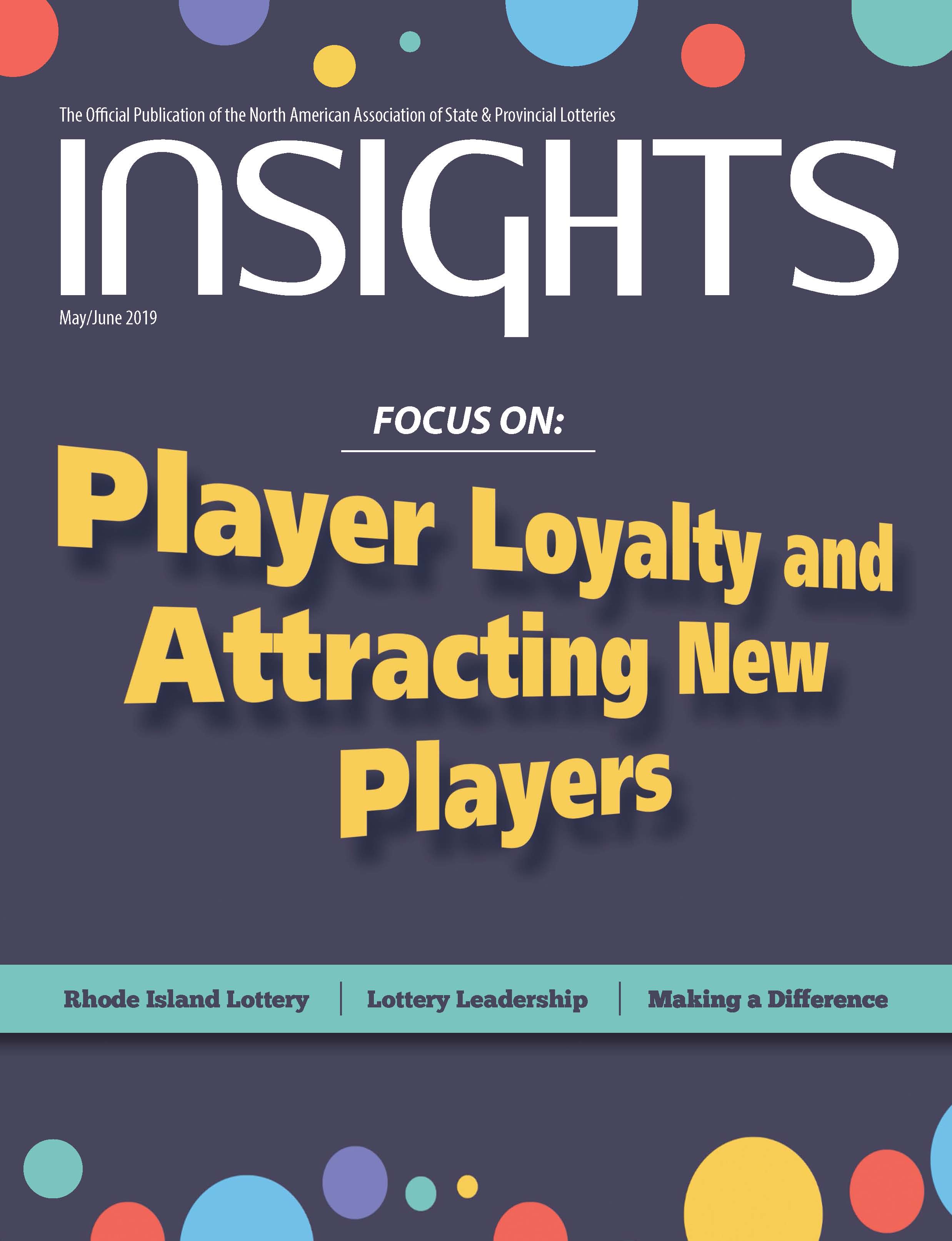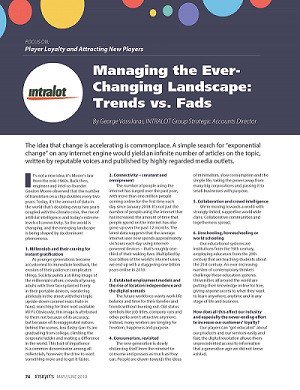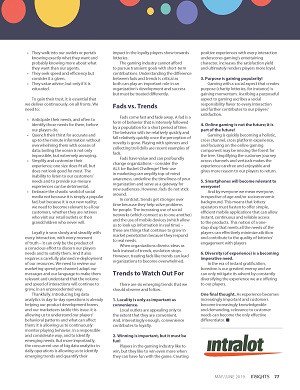Managing the ever-changing landscape | Trends vs Fads_Lottery Insights May-June 2019



By George Vassilaras, INTRALOT Group Strategic Accounts Director
The idea that change is accelerating is a common place. A simple search for “exponential change” on any internet engine would yield an infinite number of articles on the topic, written by reputable voices and published by highly regarded media outlets.
It’s not a new idea; it’s Moore’s law from the mid-60s. Back then, engineer and Intel co-founder Gordon Moore observed that the number of transistors on a chip doubles every two years. Today, it’s the amount of data in the world that’s doubling every two years coupled with the climate crisis, the rise of artificial intelligence and today’s extreme levels of connectivity.
So, the world is changing, and the emerging landscape is being shaped by six dominant phenomena;
Millennials and their craving for instant gratification
As younger generations get used to immediate feedback, the wearing away of their patience complicates things.
Society paints a striking image of the Millennial culture; crowds of young adults with their faces planted firmly in their portable devices, wandering aimlessly in the street with their ‘triple upside-down caramel macchiato’ in hand, searching for their next available Wi-Fi.
Obviously, this image is attributed to them not because of its accuracy, but because of its exaggerated nature; behind the scenes, less flashy Gen Y’s are graduating from college, climbing the corporate ladder, and making a difference in the world.
This trait of impatience, however, is a common denominator among all millennials; the drive to want something more, and to get it faster.
Connectivity; constant and omnipresent
The number of people using the internet has pitched over the past year, with more than one million people coming online for the first time each day since January 2018. It’s not just the number of people using the internet that has increased; the amount of time that people spend on the internet has also gone up over the past 12 months.
Latest data suggests that the average internet user now spends approximately 6 hours each day using internet-powered devices – that’s roughly one-third of their waking lives. Multiplied by 4 billion of the world’s internet users, we end up with a staggering 1 billion years online in 2018.
Outdated employment models and the rise of location independence and the digital nomads
The future workforce wants work life balance and time for their families and friends without burning out. Old status symbols like job titles, company cars and other perks aren’t attractive anymore. Instead, many workers are longing for freedom, happiness and purpose.
Consumerism, revisited
The new generation is slowly distancing itself from the mindset to consume and possess as much as they can. People are drawn towards the ideas of minimalism, slow consumption and the simple life, taking power away from many big corporations and passing it to small, businesses with purpose.
Collaboration & crowd intelligence;
We’re moving towards a world with strongly linked, supportive, worldwide clans. Collaborative communities and togetherness expand and spread.
Unschooling, homeschooling or world schooling
Our educational systems are institutions from the 19th century, employing educators from the 20th century that are teaching students about the 21st century... An ever-increasing number of contemporary thinkers challenge these educational systems. Universities all-around the world are putting their knowledge online for free, giving anyone access to what they want to learn anywhere, anytime and in any stage of life and business.
How does this affect our industry and especially the never-ending effort to increase our customers’ loyalty?
Our players can ‘get educated’ about our products and our services easily and fast; the digital revolution allows them unprecedented access to information that a generation ago we did not know it existed.
- They walk into our outlets or portals knowing exactly what they want and probably knowing more about what they want than our agents
- They seek speed and efficiency but consider it a given.
- They value advice, but only if it is educated.
To gain their trust, it is essential that we deliver continuously, on all fronts; we need
- to anticipate their needs, and often to identify them for them, before our players do.
- to quench their thirst for accurate and up to minute information without overwhelming them with oceans of data; boiling the ocean is not only impossible, but extremely annoying.
- to simplify and customize their experience; one size does fit all, but does not look good for most… the inability to listen to our customers needs and to provide ‘sur-mesure’ experiences can be detrimental.
- to embrace the chaotic world of social media not because it is simply a popular fad, but because it is our new reality; we need to become relevant to all our customers, whether they are retirees who visit our retail outlets or their grandchildren who never will.
Loyalty is won slowly and steadily with every interaction, with every ‘moment of truth’… it can only be the product of a conscious effort to discern our players’ needs and to satisfy them. And it also requires a carefully planned re-deployment of our resources. We need to review our marketing spent per channel, adapt our messages and our language to make them relevant and we need to understand that the volume and speed of interactions will continue to grow, at an unprecedented way.
Thankfully, introducing bid data analytics in day-to-day operations is already helping our product development teams and our marketeers to tackle this issue. It is also allowing us to understand our players behavioral patterns and what can affect them; it is allowing us to continuously monitor playing behavior, in a responsible and considerate way, and to identify emerging needs. But more importantly, the concurrent use of bid data analytics in daily operations is allowing us to identify emerging trends and quantify their impact in the loyalty players show towards lotteries.
The gaming industry cannot afford to pursue transient goals with short-term contribution. Understanding the difference between fads and trends is critical as both can play an important role in an organization’s development and success but must be treated differently.
Fads come fast and fade away
A fad is a form of behavior that is intensely followed by a population for a short period of time. The behavior will rise relatively quickly and fall relatively quickly once the perception of novelty goes away. Playing with spinners and collecting troll dolls, are recent examples of fads.
Fads have value and can really change organizations- consider the ALS Ice Bucket Challenge! Their use in marketing can amplify top-of-mind awareness, underline the timeliness of your organization, and serve as a gateway for new audiences. However, fads do not stick around.
Trends solve problems and get stronger over time
Trends get stronger over time because they help solve problems for people; the increasing use of social networks (that connects us to one another), the use of smartphones (that allow us to look up information in real time)... these are things that continue to grow in market penetration because they respond to real needs.
When organizations dismiss ideas as fads instead of trends, evolution stops. However, treating fads like trends can lead organizations to become overwhelmed.
So, what are trends we should watch out for?
There are six emerging trends that we should observe and follow;
- Locality is only as important as convenience. Local outlets are appealing only to the extent that they are convenient. And, interestingly enough, convenience contributes to loyalty.
- Winning is important, but it must be fun! Players in the gaming industry like to win, but they like to win even more when they can have fun with the game. Creating positive experiences with every interaction, underscores gaming’s entertaining character, increases the satisfaction yield, and ultimately renders players more loyal.
- Purpose is gaining popularity! Gaming with a social aspect that creates purpose (charity lotteries, for instance) is gaining momentum. Ascribing a purposeful aspect to gaming ascribes a social responsibility flavor to every interaction and further contributes to our players satisfaction.
- On-line gaming is not the future; it is part of the future! Gaming is quickly becoming a holistic, cross channel, cross platform experience and focusing in the online gaming component maybe missing the forest for the tree. Simplifying the customer journey across channels and verticals, makes the experience carefree and enjoyable and gives more reason to our players to return…
- Smartphones will become relevant to everyone! And by everyone we mean everyone, irrespective of age and/ or socioeconomic background. This means that lottery operators must hasten to offer simple, efficient mobile applications that can allow instant, continuous and reliable access to the products. This notion of one-stop shop that meets all the needs of the players can effectively minimize attrition and contribute to the quality of the lotteries’ engagement with players
- Diversity (of experience) is becoming an imperative need. In the era of instant gratification, boredom is our greatest enemy and we can only mitigate its advent by constantly diversifying the experience we are offering to our players.
One final thought…
As experience becomes increasingly important and customers increasingly knowledgeable and demanding, relevance to customer needs can become the only effective differentiator.